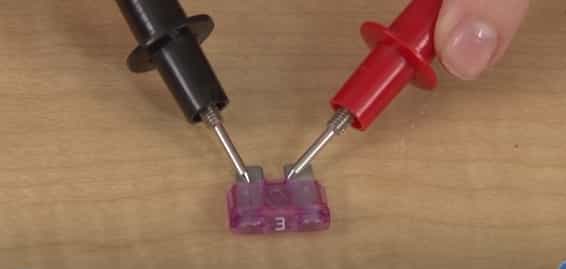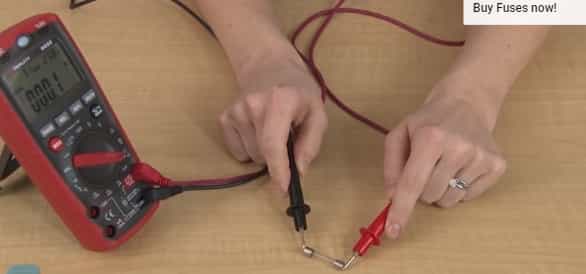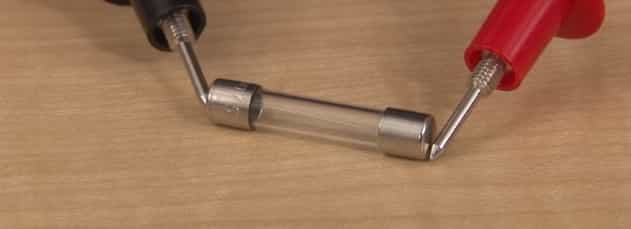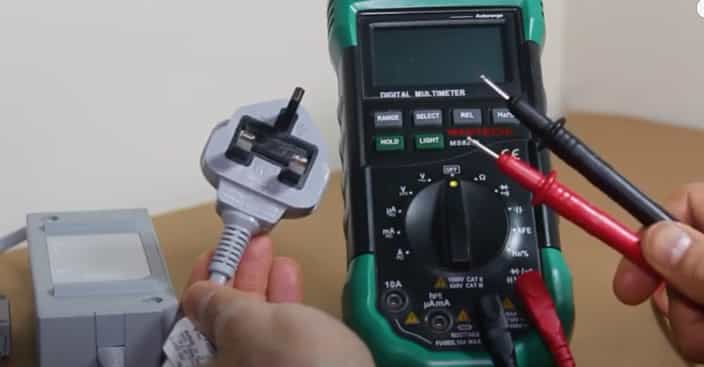Cars and homes which prevent the usage of modern circuits in electrical appliances use ceramic fuses. Sometimes before installing the fuse, it is mandatory to check whether they are working or not. We can test ceramic fuses with a multimeter. Even we can check the fuse without using a multimeter. In this context, we’re going to talk about how to test a ceramic fuse step by step.
Method 1: Steps involved in testing the fuse

Part 1: Learning about fuses and multimeters
Know fuses: What is a ceramic fuse?
Fuses are made up of just fragile wires, which are not supposed to be last for longer. Instead, they just prevent damage to the most costly things in homes.
If too much power is supplied to the circuit, which is not good for electrical appliances, the fuse will blow out, saving all the appliances at safety. Here is a description of the fuses. The cartridge fuse is a cylinder fuse. Read more, how to make ceramic decals.
It has been in used for many years. It is used in homes, from small devices to large ones. They contain metal contacts at the ends and the center. They have a tube that includes the fragile wire.
The blade fuse is the most common type of fuse. Blade fuse is in use for the past 20-30 years. They are being used convent into the bank, and relatively little space is required for them.
How does a multimeter works
An electrical millimeter is used to measure the different currents like AC, DC, and electrical resistance. Form testing the fuse, you can use the ohm.
A millimeter consists of positive and negative lead end. Millimeter contains its little battery. This battery is used to spread current through the circuit. And the measure of resistance tells about that how much current is being passed from the circuit currently. This is how a multimeter works.
Why do we need to test ceramic fuse?
Fuses tell about what is happening in the electrical circuits of a car or home. So the question is, why we test the fuse?
It is easy to examine the fuse only instead of examining the whole electrical appliances present in the home. It is easier to test fuse than testing each and everything. Other components involve complex wiring, which you may not familiar with. Also read, how to make ceramic beads?
Also, many circuits and car parts cannot be inspected at home; they must be examined at the repair shop. So testing with a millimeter is relatively easier and quicker to do. Many fuses give you visual confirmation that they are functioning correctly, and you do not need to open the fuse.
Part 2: TESTING THE FUSE:
Turn equipment off:
The first step in checking the fuse is turning the whole equipment and switching it off from the circuit.
It is necessary because, in case of any mishap, it will save the appliances from distortion. Taking fuse off from the circuit is the next step. This Is easy because there is no need for a screwdriver or any other electrical equipment to remove the fuse from the circuit. Nowadays, many fuses have a glass appearance from the outside.
Turn the meter on:
The next step is turning the meter on. This is done to check the continuity in the circuit. Meter is turned on, and it is pointed to a continuity setting. This setting looks like the five vertical curved lines.
Here is an important thing to check the working of the multimeter first. Both ends of wires are touched mutually, and the beep sound is observed. If it happens, then the meter is properly working.
In case you want to measure the resistance, use the multimeter setting that has the omega symbol.
Checking the fuse
This is the prime step of checking the fuse. Both ends of leads are placed on the ends of the fuse, and reading is observed. This step doesn’t require any professional person to perform because the fuse consists of a simple wire with no complex part.
Any person with basic knowledge can check it out. Also, it doesn’t matter which side receives the positive end and which end receives the negative end.
Test the ceramic fuse

The fuse is tested carefully. When both ends of the wire have been attached, now listen carefully to the sound of a beep. This sound should come continuously from the multimeter. This shows that fuse is properly working.
If you hear no sound from the multimeter, it has malfunctioned. This fuse needs to be replaced immediately.
In case you are using the digital multimeter, follow these steps to check the working of the fuse.
Touch both probes of the digital multimeter together to check the reading on the digital multimeter.
Note that reading and write it down. Now place both probes at the ends of the fuse and check the reading on the digital meter once again. If the reading is similar to the note before, then the fuse is working. If you get “OL” on screen, it implies that the fuse needs to be replaced with a new one.
And in case reading on the screen in “open” or “Not complete” means the fuse is broken.
Method 2: Test the ceramic fuse without a multimeter

A finger-safe terminal with the correct voltage bulb is always a safe method to check the ceramics fuse’s configuration.
It should be assured first that there is no makeshift wire touching the metal surface that could bring some harm to you or can cause the circuit explosion. Now, place one wire on the neutral side and one wire on the fuse’s load side.
Both cables have a small interconnected bulb that will glow, noticing the voltage. On placing the wires on both sides, the bulb will pop up if there will be some voltage. If there is even nominal voltage coming via wires, the bulb will be lit up.
If no such thing happens, you need to replace the fuse quickly, as it malfunctions. This test also differentiates between ghost reading and real reading. This is standard criteria to check in case you don’t have any access to a solenoid type meter.
Step-by-Step Guide to Testing a Ceramic Fuse
Testing a ceramic fuse is a straightforward process to determine if it’s functioning correctly. Ceramic fuses are commonly used in electrical systems to protect against overcurrents. Here’s a step-by-step guide to testing a ceramic fuse:
Materials You’ll Need:
- Multimeter: A digital multimeter is the most suitable tool for this task.
- Safety Glasses: To protect your eyes during the testing process.
- Replacement Fuse (Optional): In case the fuse needs to be replaced.
Steps to Test a Ceramic Fuse:
- Safety Precautions: Before you begin, ensure that the power to the circuit or device connected to the fuse is turned off. This is essential to prevent electrical shock or injury.
- Visual Inspection: Visually inspect the ceramic fuse for any signs of physical damage, such as cracks, burns, or discoloration. If you see any damage, replace the fuse immediately.
- Select the Right Range on Your Multimeter: Set your multimeter to the continuity or ohms (Ω) mode. If you’re not sure which mode to use, consult the multimeter’s user manual.
- Testing the Fuse:
- Touch the multimeter probes to each end of the ceramic fuse. Ensure that there is a secure connection between the probe tips and the fuse terminals.
- If the fuse is intact and functioning correctly, the multimeter will display a very low resistance reading (close to zero ohms) or indicate continuity with a beep.
- If the multimeter displays an “OL” (overload) or a high resistance reading, this indicates that the fuse is blown and needs to be replaced.
- Replace the Fuse (If Necessary):
- If the ceramic fuse is blown, safely remove it from the circuit by pulling it out of its holder or socket.
- Replace it with a new fuse of the same amperage rating. The amperage rating is typically marked on the fuse or the circuit it protects. Using the correct amperage-rated fuse is crucial to maintaining the safety and functionality of the circuit.
- Reconnect Power: After replacing the fuse, turn the power back on to the circuit or device and ensure that it operates correctly.
Important Tips:
- Always exercise caution when working with electricity. Ensure that the power is off and take appropriate safety measures to avoid electrical shocks or injuries.
- When handling ceramic fuses, avoid touching the metal ends of the fuse or any exposed electrical components.
- If you’re unsure about the condition of the ceramic fuse or the cause of the circuit issue, it’s a good idea to consult a qualified electrician or technician for further diagnosis and repair.
Testing a ceramic fuse is a simple process that can help you identify and address electrical issues caused by a blown fuse. Regular maintenance and prompt replacement of damaged fuses are essential for the safety and proper functioning of electrical circuits and devices.
Troubleshooting Common Ceramic Fuse Testing Issues
Troubleshooting common issues that may arise during the testing of ceramic fuses can help ensure accurate results and safe electrical troubleshooting. Here are some common problems and solutions:
1. Multimeter Displaying “OL” (Overload):
- Issue: If your multimeter displays “OL” (overload) when testing a ceramic fuse, it may indicate an issue with the multimeter or the test setup.
- Solution:
- Check the multimeter’s leads and connections to ensure they are securely attached to the fuse terminals.
- Verify that you are using the correct range on the multimeter. Switch to a lower resistance or continuity range if needed.
- Test the multimeter’s functionality by checking it against a known-good circuit or component.
2. Multimeter Displaying High Resistance or No Continuity:
- Issue: When testing a ceramic fuse, if the multimeter displays a high resistance reading or no continuity (no beep), it suggests that the fuse is blown.
- Solution:
- Replace the ceramic fuse with a new one of the same amperage rating. Blown fuses must be replaced to ensure proper circuit protection.
3. Difficulty in Accessing the Fuse:
- Issue: Sometimes, the ceramic fuse may be located in a tight or hard-to-reach spot, making it challenging to access and test.
- Solution:
- Use appropriate tools, such as needle-nose pliers or fuse pullers, to safely and carefully remove the fuse from its holder or socket.
- If access is limited, consider using extension cables for your multimeter probes to reach the fuse more easily.
4. Inconsistent Readings:
- Issue: You may encounter inconsistent or fluctuating readings on the multimeter, making it difficult to determine the fuse’s condition.
- Solution:
- Ensure that the multimeter probes are making good contact with the fuse terminals. Clean the terminals if necessary to remove any oxidation or debris that may interfere with the connection.
- Check the integrity of the multimeter probes and leads, as damaged or frayed cables can cause unreliable readings.
- Test the ceramic fuse multiple times to confirm the consistency of the readings.
5. Fuse Appears Intact but Still Has Issues:
- Issue: Sometimes, a ceramic fuse may appear visually intact but still cause electrical problems.
- Solution:
- Even if a ceramic fuse looks fine, it could be internally damaged. Perform a continuity test to determine if it is functioning correctly. If the continuity test fails, replace the fuse.
6. Incorrect Amperage Rating:
- Issue: Using a ceramic fuse with the incorrect amperage rating can lead to issues in testing and operation.
- Solution:
- Always use a ceramic fuse with the correct amperage rating as specified for the circuit. Using the wrong amperage rating can lead to inadequate protection or nuisance tripping.
7. Circuit Still Not Functioning After Fuse Replacement:
- Issue: If the circuit or device still doesn’t work after replacing the ceramic fuse, there may be an underlying issue.
- Solution:
- The blown fuse may have been a symptom of a more significant problem. Investigate the circuit further to identify and address the root cause, which could include short circuits, faulty components, or wiring issues.
If you encounter persistent issues when testing ceramic fuses, or if you are unsure about the results of your testing, consider seeking the assistance of a qualified electrician or technician to ensure the safety and reliability of your electrical system.
Common mistakes while testing ceramic fuse
esting ceramic fuses is a relatively simple process, but there are some common mistakes that people can make, which can lead to inaccurate results or even damage to the fuse or testing equipment. Here are some common mistakes to avoid when testing ceramic fuses:
Not Turning Off Power:
- Mistake: Failing to turn off the power to the circuit or device before testing the ceramic fuse.
- Why It’s a Mistake: Testing a fuse with live electrical current can be extremely dangerous and may lead to electrical shock or damage to testing equipment.
- Solution: Always ensure that the power to the circuit or device is turned off before attempting to test a ceramic fuse.
Using the Wrong Multimeter Setting:
- Mistake: Selecting the incorrect setting on the multimeter (e.g., voltage instead of continuity or resistance) for testing the ceramic fuse.
- Why It’s a Mistake: Using the wrong setting can yield misleading results and make it difficult to determine the fuse’s condition.
- Solution: Set the multimeter to the appropriate continuity or resistance mode for testing fuses. Refer to the multimeter’s user manual if you’re unsure about the settings.
Testing in the Circuit:
- Mistake: Attempting to test the ceramic fuse while it is still installed in the circuit or device.
- Why It’s a Mistake: Testing a fuse in the circuit can provide inaccurate results because other components may influence the readings.
- Solution: Remove the ceramic fuse from its holder or socket before testing it to get an accurate assessment of its condition.
Not Visually Inspecting the Fuse First:
- Mistake: Neglecting to visually inspect the ceramic fuse for physical damage before conducting electrical tests.
- Why It’s a Mistake: Visual inspection can quickly identify visible cracks, burns, or other issues that may make further testing unnecessary.
- Solution: Always examine the fuse for any visible damage before proceeding with testing.
Ignoring Safety Precautions:
- Mistake: Not wearing safety glasses or gloves when working with ceramic fuses.
- Why It’s a Mistake: Ceramic fuses can shatter when damaged or subjected to pressure, potentially causing eye or hand injuries.
- Solution: Use safety glasses to protect your eyes and wear disposable gloves when handling ceramic fuses.
Not Replacing Blown Fuses:
- Mistake: Failing to replace a blown ceramic fuse with a new one.
- Why It’s a Mistake: Blown fuses need to be replaced to maintain proper circuit protection.
- Solution: If you determine that a ceramic fuse is blown, replace it with a new fuse of the same amperage rating.
Using Excessive Force:
- Mistake: Applying excessive force when removing or reinserting a ceramic fuse.
- Why It’s a Mistake: Excessive force can damage the fuse or its holder.
- Solution: Gently and carefully remove and insert the fuse to avoid any unnecessary force.
Not Double-Checking the Correct Amperage Rating:
- Mistake: Using a ceramic fuse with the wrong amperage rating when replacing a blown fuse.
- Why It’s a Mistake: Using the incorrect amperage rating can lead to inadequate protection or circuit issues.
- Solution: Always ensure that the replacement fuse has the correct amperage rating as specified for the circuit.
By avoiding these common mistakes and following proper testing procedures, you can accurately assess the condition of ceramic fuses and ensure the safety and functionality of electrical circuits and devices.
FAQ’s of testing ceramic fuse
Certainly, here are some frequently asked questions (FAQs) about testing ceramic fuses:
What is a ceramic fuse, and what is its purpose?
A ceramic fuse is a type of electrical safety device designed to protect circuits and devices from overcurrents or short circuits by breaking the electrical connection when the current exceeds a certain limit.
How do I know if I should test a ceramic fuse?
You should test a ceramic fuse if you suspect a circuit or device is not functioning due to a blown fuse. Visual inspection or the absence of power can be indicators.
Can I test a ceramic fuse while it’s still in the circuit?
It’s best to remove the ceramic fuse from the circuit before testing to ensure accurate results. Testing in-circuit may yield misleading readings due to the influence of other components.
What equipment do I need to test a ceramic fuse?
You will need a multimeter set to continuity or resistance mode, safety glasses, disposable gloves, and, if necessary, a replacement fuse of the same amperage rating.
What should I check for during a visual inspection of the ceramic fuse?
Look for visible signs of damage, such as cracks, burns, or discoloration. If the fuse shows any of these signs, it may need replacement.
How do I set my multimeter for testing a ceramic fuse?
Set your multimeter to continuity or resistance mode. Consult the multimeter’s user manual if you’re unsure about the correct setting.
What is the expected reading when a ceramic fuse is intact?
When a ceramic fuse is intact, the multimeter should display a very low resistance reading (close to zero ohms) or indicate continuity with a beep.
What does it mean if the multimeter displays “OL” or a high resistance reading when testing a ceramic fuse?
“OL” (overload) or a high resistance reading indicates that the ceramic fuse is blown and needs replacement.
Can I reuse a ceramic fuse after testing it?
It’s generally not recommended to reuse a ceramic fuse once it has been tested or removed, as it may no longer provide reliable protection.
What should I do if I find a blown ceramic fuse during testing?
Replace the blown ceramic fuse with a new one of the same amperage rating to maintain proper circuit protection.
Can I test ceramic fuses with a digital multimeter?
Yes, a digital multimeter is suitable for testing ceramic fuses. Set it to the appropriate mode for continuity or resistance testing.
Is it necessary to wear safety glasses and gloves when testing ceramic fuses?
Yes, it’s a good practice to wear safety glasses to protect your eyes from potential shattering of ceramic fuses and disposable gloves to prevent contamination and protect your hands.
What should I do if I’m unsure about the condition of a ceramic fuse after testing?
If you have doubts about the results or the condition of the fuse, it’s advisable to consult a qualified electrician or technician for further evaluation and troubleshooting.
Conclusion
In conclusion, testing a ceramic fuse is a fundamental skill for anyone dealing with electrical circuits and devices. By following the correct procedures and safety precautions, you can quickly determine the condition of a ceramic fuse, whether it’s intact and functioning correctly or blown and in need of replacement.
Visual inspection, followed by a multimeter test in continuity or resistance mode, provides a reliable method for assessing the fuse’s condition. If the multimeter displays “OL” or a high resistance reading, it indicates a blown fuse that should be promptly replaced with one of the same amperage rating.
Remember that safety is paramount when working with electrical components. Always turn off the power to the circuit, wear safety glasses and gloves, and handle ceramic fuses with care to prevent injury.
By mastering the process of testing ceramic fuses, you can maintain the integrity of your electrical systems, troubleshoot circuit issues effectively, and ensure the safe operation of your devices and appliances.


